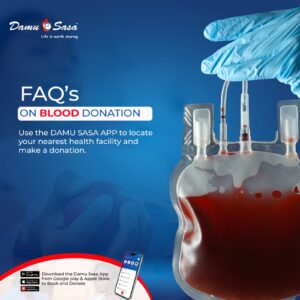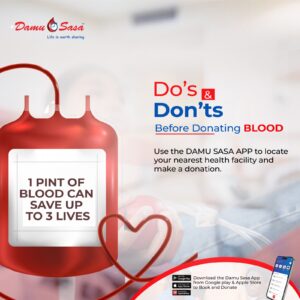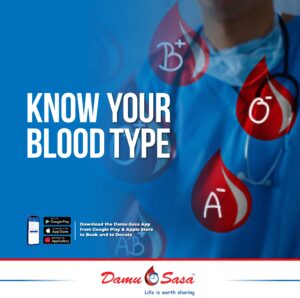By Damu Sasa
Over the past couple of months, there has been rising public interest, on where their blood goes after donation. In part, this interest was sparked by claims that donated blood was being illegally sold in Somalia.
The claims not only caused uproar from members of the public, but also likely negatively impacted regular, voluntary, and non-remunerated blood donations.
The worst of this was experienced in 2020, during what is generally considered as the peak of the COVID-19 pandemic in Kenya. Accordingly, total collections for that year were less than 100,000 blood units, according to the Kenya National Blood Transfusion Service (KNBTS). This is despite the target being 500,000 to 1 million (at least 1% of the Kenyan population) blood unit collections set by the World Health Organization (WHO).
Such shortfalls on blood donations place many patients at an elevated risk of losing their lives due to delayed or lack of transfusion. Mothers and children bear the brunt of this risk as they account for close to 60% of all transfusions in Kenya.
Fortunately, there was an upswing in 2021 with doubling of units collected, in part as a result of collective efforts on blood donor education and mobilization from both the public and private sectors. However, the rise was still not enough to meet the required blood unit collection targets.
While a lot has and continues to be done to mitigate blood donor apathy, there still remains a lot to do, especially in the space of blood donor education. Donor awareness will lay stark the impact donated blood has on saving lives as well as demystify the whole subject to potential donors.
A key aspect of enlightenment is what happens to one’s blood once donated. Specifically, the process and procedures between blood donation and transfusion need to be understood by the public. Doing this will allay public fear, especially on the aspect that some parties could be selling blood; a ‘commodity’ that is freely given to save lives. If well-executed, this understanding could start denting the levels of apathy witnessed today.
Once donated, blood is kept in 2-6◦ C refrigerated storage. This is so as to prevent bacterial growth in the blood, and by so doing, stretch its ‘shelf-life’ to at least 35 days. This is especially the case for whole blood donations, which are the most common in Kenya.
If the blood was donated in open air, it is prepared for transportation to an approved lab for screening.
Preliminary screening involves grouping to determine the blood group of the donated unit, and establishing the volume of the blood unit. The WHO recommendation is for each unit to be 450ml to qualify to be transfused to a patient. This is because, in some cases where the donated volume is below 450ml, the blood is likely to be contaminated by the anticoagulant present in blood bags, thereby losing its utility for safe transfusion to patients.
After the preliminaries, the donated blood is tested for TTIs (Transfusion Transmitted Infections) to ascertain its safety and suitability for transfusion. The various TTI tests include: HIV, Hepatitis B and C, Syphilis, and Malaria. Beyond TTI testing, nowadays most labs test for convalescent plasma, due to the ongoing COVID-19 pandemic.
Units that fail even one of the TTI tests are normally either earmarked for disposal, or further testing and analysis. Donors of these particular units are normally followed up on for referral to needed care.
Units that pass all the tests are then approved for transfusion, pending component preparation. It is becoming more and more common to transfuse components of the blood rather than whole blood.
Component preparation is the separation of various blood products from whole blood donations. This is done with the use of specialized equipment known as refrigerated centrifuges. The blood products separated normally include red blood cells, platelets, and plasma.
According to the American Family Physician Journal, Red blood cells are used in transfusion to treat haemorrhage and to improve oxygen delivery to tissues. This is especially for patients with either symptomatic anaemia or acute sickle cell crisis.
Platelets, on the other hand, according to Medscape, are used for treating patients who suffer the risk of acute bleeding as a result low platelet volume count. This is especially patients with leukemia.
Last but not least, according to the Red Cross, plasma transfusions are for patients with liver failure, severe infections, and serious burns.
Once all components are ready, and have been approved as safe for transfusion, they are then sent to inventory, awaiting compatibility testing against patient samples, before final transfusion to patients.
We hope you now have a good idea of where or what happens to your donated blood. We trust that you will use and share this information towards your conscious decision to save lives through blood donation.
Please feel free to download the Damu Sasa mobile app from the google Playstore, to find your nearest centre for blood donation, as well as join a community of like-minded individuals keen on saving lives
through blood donation. In any case, life is worth sharing.
Damu Sasa is a homegrown and youth-led end-to-end (vein-to-vein) blood services information management platform, built to aid in the effective blood services management, by facilitating timely access to safe blood and blood products for transfusion to patients.
![]()







